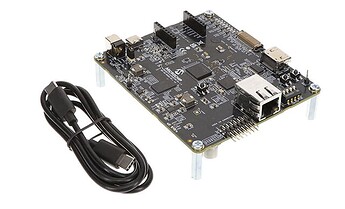What is an example of embedded microcontroller rapid prototyping?
Rapid prototyping captures the community, hardware, software, and web services used to quickly convert an idea to a working prototype. An example is the MikroElektronika 4G LTE&GNSS CLICK board as shown in Figure 1. This breakout board adds cellular connectivity and GNSS navigation to an embedded project. NECTO Studio software is provided to assist with configuration and code development. For example, the LTE&GNSS board featured in Figure 1 could be added to the Microchip Curiosity board shown in Figure 2. This system can be quickly programmed along with cloud services to provide a proof of concept.
Note that we can expand the rapid prototyping ecosystem to encompass products such as the Raspberry Pi Compute Module Development Kit. Also, products such as the Silicon Labs Busy Bee EFM8BB50 PRO KIT shown in Figure 4 extend the rapid development ecosystem into the low-energy embedded applications.
Figure 1: The LTE&GNSS MIKROE Click board quickly adds remote cell connectivity and GPS navigation to your prototype.
Tech Tip: Rapid prototyping is best viewed as a journey. It begins with an idea and ends with production of the product. The goal is to move as quickly as possible through these stages. Fast development times yield greater Return On Investment (ROI). Note that production quantity has a profound impact on prototyping. It’s a continuum where small production runs may use the same hardware as the prototype while large production runs are highly optimized for cost.
Please refer to this article for additional information.
Figure 2: This Microchip 64-bit quad-core RISC-V development board features a MIKROE socket.
How Digikey supports rapid prototyping
DigiKey is a distributor of components including a wide variety of embedded components ranging from individual microcontrollers to SOMs. DigiKey also offers a range of microcontroller-adjacent sensors, ADCs, and DACs with a wide variety of interfaces including parallel, I2C, SPI, and QSPI.
-
Initial Demonstration For the initial stages, DigiKey offers maker friendly and professional rapid prototyping platforms such as ST Nucleo, Microchip Curiosity, Arduino, Raspberry Pi, and MikroElektronika modules. These hardware platforms are supported by the tremendous generosity of the supporting community. In many cases, the designer can move from an idea to working proof-of-concept within a few days.
-
Design for Manufacturing: This stage requires fast decisive action to maintain a reasonable ROI. DigiKey provides a large variety of off-the-shelf solutions allowing the designer to mix and match discrete components and modules. Key advantages include:
-
DigiKey’s in-stock availability and speed are paramount.
-
The parametric search engine is the designer’s best friend as are the datasheets that accompany each DigiKey product page. We can even perform a reverse lookup to identify closely related parts.
-
Support via this TechForum may be utilized.
-
-
Production: The production process is an extension of the design for manufacturing. The most important considerations are speed, cost, and availability as you kit your components for the pick-and-place machine. DigiKey remains a reliable logistics partner as your project scales.
Figure 3: The Raspberry Pi Compute Module 5 kit provides an environment for embedded prototyping.
Tech Tip: The reverse lookup is a powerful feature of DigiKey’s parametric search engine. Given a known part, it allows us to locate similar parts based on the part attributes. This article on complementary transistors describes the process.
Understanding the reverse lookup is a time saving process especially when we move to staging parts (kitting) for the product run.
Figure 4: The EFM8 Busy Bee facilitates low energy prototyping. It has an expansion header and a small TFT display.
Parting thoughts
What are your go-to DigiKey products for rapid prototyping? Share your thoughts and recommendations below.
Let us know how DigiKey can support your next-level project.
Best wishes,
APDahlen
Related information
Please follow these links to related and useful information:
About this author
Aaron Dahlen, LCDR USCG (Ret.), serves as an application engineer at DigiKey. He has a unique electronics and automation foundation built over a 27-year military career as a technician and engineer which was further enhanced by 12 years of teaching (interwoven). With an MSEE degree from Minnesota State University, Mankato, Dahlen has taught in an ABET-accredited EE program, served as the program coordinator for an EET program, and taught component-level repair to military electronics technicians. Dahlen has returned to his Northern Minnesota home and thoroughly enjoys researching and writing articles such as this.




